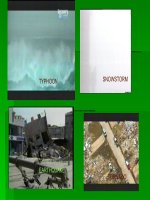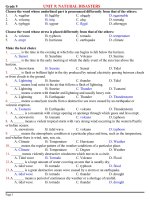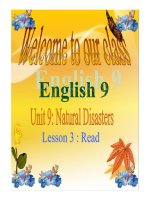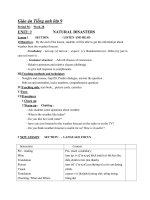Unit 9 Natural disaters
Bạn đang xem bản rút gọn của tài liệu. Xem và tải ngay bản đầy đủ của tài liệu tại đây (129.52 KB, 11 trang )
<span class='text_page_counter'>(1)</span>Date of planning: Date of teaching:. Period 55 Unit 9 Natural disasters Lesson 1: Getting started Listen and Read. I Aims and objectives: - Listening and reading a dialogue for detail information about a weather forecast - By the end of the lesson , Ss will be able to get to know and use new words about weather. Understand the information in a weather forecast. II/ Teaching aids: Text books , board , cassette , pictures. III/ Procedure: A. Class organization - Greeting - Check the attendance : B. New lesson 7 min I/ Warm up: Guessing game (Weather forecast) = > Provide three clues about the word “ weather forecast “ 1. We know whether it is going to rain or to be sunny if we watch this program. 2. It is usually broadcasted on TV after the news. 3. It starts with letter S - Chatting about this topic: 1. Do you usually watch the weather forecast ? 2. Do you think weather forecasts are truthful ? 10 min. II/ Presentation 1. Vocabulary pre-teach: Introduce the contents of the lesson and some words: - Snowstorm (n): heavy fall of snow especially with wind - Earthquake (n): picture - Volcano (n) : picture - typhoon (n): violent storm especially in East Asian seas. - ask Ss to match the picture to the correct words and then compare their answer with a partners. - Call on some Ss to report and give answer key: 1. snowstorm 2. earthquake 3. volcano 4. typhoon Ask Ss to look at the picture and answer the question In which program do we see these pictures ? => setting the scene: “ Thuy is talking to her grandmother while they are watching a weather. Whole class - Guess the word. => Weather forecast - Answer - listen carefully Listen and repeat , then guess its meanings. - copy down - Match - Give their predictions.. => in weather forecast - Listen carefully.
<span class='text_page_counter'>(2)</span> forecast on TV. Now look at the book and listen to the tape. 15 2. Practice: min - Turn on the tape (2 or 3 times) if necessary. - Ask Ss to practice the dialogue in group of three. - Have Ss work individually to fill in each blank one word and phrase from the dialogue. - Call on some Ss to read aloud their completed sentences in front of class. => Give correct answers: 1. turn up - weather forecast 2. raining 3. central highlands 4. have temperatures 5. weather forecasts - Ask Ss to read the dialogue again to do this exercise: True or false . Correct the false ones 1. There will not be any sunshine in Hanoi 2. Temperature in Hue will be over 30oC 3. It will be cloudy in Cuu Long Delta. 4. Thuy is going out for a picnic with her old friends 5. Thuy,s gandmother asks her to bring along a warm coat. 6. Thuy follows her grandmother,s advices. - Call on some Ss to explain their answers in front of class. Comment and give answers: 1. F. It will be sunny 2. F.The temperatures will be between 25oC and 30oC 3.T 4.T 6.T 5. F – She asked Thuy to bring along a rain coat. 10 4. Production: min - Ask Ss to work in group of 3 or 4 and discuss to make a weather forecast for the following day in Vietnam - Call on some representatives from groups to read forecast aloud in front of class. - Comment and make necessary corrections. 3 min 5. Home work: 1. Summarize main point 2. Learn by heart new words. 3. Prepare the next lesson. Date of planning: Date of teaching:. - Work in groups of three. - Demonstrate - Copy. - Work in group. - Demonstrate. - Write down. - Work in group - Read them loudly - Copy down. Period 56 Unit 9 Natural disasters Lesson 2: Speak. A/Aims and objectives: Practice speaking bout preparations made for a typhoon.
<span class='text_page_counter'>(3)</span> Ss will be able to know what should be prepared for a typhoon and improve the discussion skills: agreeing and disagreeing. B /Teaching aids: Textbook , whiteboard markers. C/Procedure: A. Class organization - Greeting - Check the attendance : B. New lesson 5 min. 10 min. I/ Warm up Question and answer: - Have there been any typhoons in our hometown ? - What should we do when there is a typhoon ? II/ Presentation:introduce the content and aim of the lesson to Ss Then introduce some new words: 1. Vocabulary pre-teach: - Bucket (n): container specially used for keeping water. - Canned food (n) food preserved by canning. - Fix the leak (v): repair the damage of the top of a building or a house. - Peg (n): wooden pin for holding thing s. - Door latch (n) door lock that can only be opened from outside with a key. - Power cut (n): the lost of the electricity supply to an area. * Checking technique: Noughts and Crosses Canned food Bucket Fix Power cut Peg Damage Door latch Roof Available. 15 min. - Remark and give marks if necessary. III/ Practice: 1. Choosing possible answers: - Ask Ss to work in pairs. - Answer (Ss can use Vietnamese to express their ideas. - Listen carefully - repeat in chorus and guess its meanings.Then copy - Give examples. - Play games (group work). - Study the list and check what should be made for a typhoon. - Compare their choice with another pair - Demonstrate..
<span class='text_page_counter'>(4)</span> - Call on some Ss to explain their answers and give suggested answers: + Buying some canned food + Buying candles + Buying matches + Filling all buckets with water. + Buying ladder +Fixing the leak in the roof + Tying the roof to the ground with pegs an ropes. + Checking all the windows and door latches. * Pair discussion -Have Ss continue working in pairs but with another partner - Call on some pairs to practice in front of class. Comment and give suggested answer: a) A: I think we should buy some candles and matches before a typhoon. B: Yes. I agree with you. Because there may be a power cut when the is strong. IV / Production: True / False repetition drill (Say seven to ten statements about what we should do to prepare for a typhoon. If the statements are true (should do) , Ss will repeat the statements. If the statements are false (should not do ) , Ss will stay silent) Examples: 1. We should buy some candles 2. We should invite some friends to dinner ……. V/ Home work: 1. Summarize main point. 2. Learn bye heart new words and structures. 3. Do exercises (1,2) in work book. => Guide Ss to do them. 4 Prepare the next lesson. * Feedback: Date of planning: Date of teaching:. - Copy in their notebooks - Practice in pair. - Correct and copy if necessary.. - Play in whole class.. - Write down in their notebooks.. Period 57 Unit 9 Natural disasters Lesson 3: listen. A / Aims and objectives: - By the end of the lesson , Ss will be able to get to know some ideas on how to live with earthquakes through sentence completion exercise. - Listen to the talk better , identify and catch key words for the answers. B / Teaching aids: Textbook , cassette and some posters about earthquakes. C / Procedure : A. Class organization.
<span class='text_page_counter'>(5)</span> - Greeting - Check the attendance : B. New lesson 5 min. I/ Warm up: Question and answer 1. Do you know anything about earthquakes ? 2. Are they dangerous ? 3. Are there many earthquakes in VietNam ? 4. In which countries do earthquakes usually occur ? 5. What would you do if an earthquake occurred ? (Before , while and after the earth quake). 10 min. 15 min. II / Listening: 1. Pre- listening: Introduce the aims of the lesson to Ss and some new words : * Vocabulary pre- teach: - Fixture (n) – translation - Block (v): prevent movement from happening. - Zone (n) = Area / region - Roller (n) (translation) Doorway (n): opening to the house Checking technique: Jumbled words (all the words above) 2. While – listening: * Setting the scene: “ An expert is giving to talk on how to live with earthquakes. Actually he will give us advice on what should we do before and during an earthquake. Listen to the talk and complete the table.” - Turn on the tape several times if necessary. - Call on some Ss to read their answers aloud. - Feedback and give correct answers. Play the tape again and stop at each answer: Answers: + Heavy fixtures , furniture , and appliances: - Place heavy books on the bottom shelf of the bookshelf. - Block the rollers on your fridge and washing machine.. Whole class - Answer. - Listen carefully. - Repeat in chorus and individually. - Guess its meanings. - Copy and give examples. - Play games in group work.. - Listen carefully. - Read the table carefully make some useful guesses for the missing words in the blanks. - Listen carefully and fill in each blank. - Demonstrate in the front. - Listen and check their answers..
<span class='text_page_counter'>(6)</span> 10 min. + Flying glass: - Check the mirrors. - Do not put your bed near a window. + Earthquakes drill: - Stay inside. - Sit under a strong table or doorway. - Stand in the corner of the room. 3. / Post - listening: Have Ss work in group. - Call on some Ss to deliver the presentation in front of class. - Comment and make corrections if necessary. 5 min. III / Home work: 1. Summarize main point. 2. Learn by heart new words. 3. Do exercise 2,4 in workbook. 4. Prepare the next lesson. * Feedback:. Date of planning: Date of teaching:. - Copy down. - Work in group and make a short presentation on how to live with earthquakes based on the information in the table. - Demonstrate.. - Copy down. Period 58 Unit 9 Natural disasters Lesson 4: Read. A/ Aims and objectives: By the end of the lesson , Ss will be able to get general background information on some common natural disasters such as earthquakes , tidal waves , typhoons , volcanoes ,and tornadoes through two comprehension exercise: True or False and Sentence completion. Reading for main ideas and specific information B / Teaching aids: Textbook , handouts of further information on natural disasters C / Procedure: A. Class organization - Greeting - Check the attendance : B. New lesson 7 min. I/ Warm up: Matching. - Work in group.
<span class='text_page_counter'>(7)</span> - Give definition of four natural disasters that Ss will learn in the lesson 1. Earthquake a. Mountain or hill with openings through which ashes and gases ejected. - Match the names of the disasters to its correct meanings.. 2. Tidal wave b. Violent storm especially in East Asian seas. 3. Typhoon c. Violent storm over small area.. 10 min. 4. Volcano d. Another word for Sunami , waves caused by tides.. - Copy. 5. Tornado e. Sudden and violent movements of the earth,s surface.. - Listen and rtepeat in chorus and individually.. - Give correct Answers: 1.e , 2.d ,3.b ,4a ,5.c. - Guess its meanings and give examples.. II / Reading: 1. Pre- reading: Introduce the aims of the lesson and some new words to Ss. * Vocabulary – Pre-teach: - Pacific Rim (n): Countries in the Pacific area. - Collapse (v): break down , falling to ruin - Abrupt (v): Suddenly happen - Shift: change - Hurricane = Cyclone = Typhoon - Erupt (v) – Eruption (n): break out or through - Funnel (n): narrowing tube for putting liquid into small opening. - Baby carriage (n): small , special vehicle for carrying baby. * Checking technique: Noughts and Crosses Pacific Rim Erupt Collapse. - Copy down notebooks.. - Play games in group. - Listen carefully and do the exercise “ True or False “. Earthquake Struck Kill. - Compare their answer with a friend and under the information in the passage for their answers. - Report in the front. Typhoon Predict. - Write down their.
<span class='text_page_counter'>(8)</span> Shift 15 min. III. While - Reading 1. Setting the scene “ We are going to read a passage about five disasters that mentioned earlier. Read and do the comprehension tasks assigned. “ - Ask Ss to do the exercise True or False. - Tell them to work independently , read the passage and decide whether the statements are true or false. Correct the false ones. - Call on some Ss to explain their answers in front of class. - Listen and give correct Answers: 1. True 2. True 3. False(The tidal wave traveled from Alaska to California) 4. True 5. False (The eruption of Mount Pinatubo is the World,s largest volcano eruption in more than 50 years. 6. True 2. Sentence Completion: -Tell Ss to read the passage more carefully and complete the sentences. Guide and explain them to understand all the given halves. - Make necessary corrections in front of class as a whole. - Give suggested answers: 1…...occur around the Pacific rim. 2……....many houses , office blocks and high ways collapsed. 3……….when there is an abrupt shift in the underwater movement of the earth. 4……….a cyclone. 5………..the word “ typhoon “ 6………..that passes overland below a thunderstorm and suck up anything that is in its path.. 10 min. notebooks.. - Complete individually. - Read them again and copy.. - work in group. - Each group has to match those numbers of the words to appropriate headings. IV / Post - reading: - Call on some Ss to read the passage aloud in front of - Listen and copy. class. - Check pronunciation mistakes if any. - Divide class into five groups. Each group takes care of one natural disaster. - Give out 20 numbers or words about five naturals.
<span class='text_page_counter'>(9)</span> disasters. - The group which completes the task the most quickly will be the winner. 90% , Kobe , 1995 , homes , 1960 , California , Movement , tide , 120 , hurricane , cyclone , Chinese words , 1991 , Philippines , 50 , eruption , funnel , Italy , 1981 , 100. Answers: Earthquake Tidal wave Typhoon Volcano Tornado 90% Kobe 1995 Homes 1960 California Movement tide 120 Hurricane Cyclone Chinese Words 1991 Philippines 50 eruption Funnel Italy 1981 100 V/ Homework: 1. Summarize main point. 2. Learn by heart new words 3. Do exercise in workbook. 4. Prepare the next lesson.. Date of planning:. Period 59 Unit 9 Natural disasters.
<span class='text_page_counter'>(10)</span> Date of teaching:. Lesson 5: write. A / Aims and objectives: By the end of the lesson, Ss will be able to write a short story by using guided information and pictures. B/ Teaching aids: Text book, white board markers. C / Procedure: A. Class organization - Greeting - Check the attendance : B. New lesson 7 min. 15 min. I / warm up : Question and answer 1. Have you ever written a story 2. What is it about ? 3. How long did it take you to write it ? 4. Did you write it in Vietnamese or in English ? 5. Do you think it is a successful one ? => Leading in the lesson. II / Writing: 1. Pre-writing: Introduce the aims of the writing and help Ss with some new words: - Circle (n): perfectly round shape - Shelter (n): a place to hide or stay away from danger - Behave (v): act in a manner. * Checking technique: Sentence modeling - Listen and correct the mistakes. * Picture explanation: - Have Ss work in pairs to ask and answer about the picture one to six by giving sample questions: Picture 1: a. What do you see in the first picture ? b. Who is she ? What is she doing ? c. What is the weather like ? Picture 2: a. What is wrong with the dog ? b. Is he behaving strangely ? c. What do you think is going to happen ? Picture 3: a. Who is in the picture with Lan ? b. What does she say ? Picture 4: a. What is happening ? b. Where are Lan,sfamily members ? Picture 5: a. Is the wind strong?. - Listen and answer the questions. - Listen carefully and repeat in chorus and individually - Make sentences with all the new words that they have learned. Listen carefully and work in pairs Implicit the content of the story by answering questions to draw an outline of the story..
<span class='text_page_counter'>(11)</span> 10 min. 10 min. 3 min. b. What is the weather like ? Picture 6: a. What do you see in the picture ? b. What are Lan and her parents doing now ? c. Does the weather become good again ? - Look at the book - Ask Ss to turn back on page 79 and study the outline and study the of the story with the guided words. outline of the story. - Write individually 2. While – Writing; (Ss can make - Have Ss write the story individually and tell them to changes and add compare their story with a friend. more details to the story to make it more interesting) - Call on some Ss to read the story loudly. - Read their writings loudly - Give suggested writing. - Compare and 3. Post - Writing: correct their Story – telling Competition: Divide class into several writings. groups. From each group , choose one member to be in the judge board. - Work in group and - Call on some Ss from group to tell the story in front individually of class. - Tell the story and Listen and remark. Then give marks to the best Ss. may tell the story they have written or 4 / Homework: a newly invented 1. Summarize main point story. 2. Copy the completed writing. 3. Do exercise in their workbook. - Listen and copy 5. Prepare the next lesson. down..
<span class='text_page_counter'>(12)</span>









